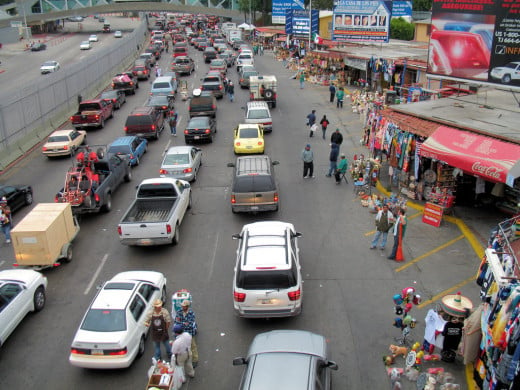How to be a Considerate, Defensive Driver
Driving Long Distances
Dealing with other drivers is probably the most unpleasant task those who drive long distances look (or don't look) forward to.
Drivers wish other drivers would be more considerate, but they need to realize that they need to be more considerate also.
Although I don't drive long distances for a living, I do my share of driving for events with my church or when working our business. Any driving we do means we need to pay attention to the road, other drivers and situations that may cause an accident to those in back of us.

There Are Several Keys to Defensive Driving and Safety While on the Road
Things You'll Need:
Patience, patience, and even more patience.
Constant surveilance
Mind set of being ready for anything.
A drivers license, or permit
Keys to defensive driving:
1) Keep your mind focused at all times surveying the road, the other drivers on the road, and be ready for any unexpected catastrophe, such as someone having a flat tire, or other problem.
The first and most important key of driving is to keep your mind focused. It is imperative for your own safety as well as that of others to hide your 'things to do' list, and all the other things you have to think about in a given day, or a given year, and devote your time at the wheel to driving, and if at all possible only thinking about driving.
If you have someone in the car with you, or children in the back seat, then you need to find someway to visit or work with the children while still remaining focused on the road. Another option is that if you have another adult traveling with you, that they can have the responsibility of focusing on the children so you can focus on the road.
2) If you are in a lane following a vehicle going quite a bit slower than yourself, for the safety of those vehicles following you, move to the passing lane faster/sooner than you would if you were alone on the road.
When driving long distances, I wonder why people wait until the last minute to pass someone going a bit slower than they are, they should be able to tell that they are gaining on the driver in front, long before they are immediately behind them.
Recently, when coming home from a church event, everything seemed to be going okay on the road, when all of a sudden a larger vehicle got within several yards (within one car length if not less) from a smaller car that was in front of them before pulling into the passing lane. The main problem was that since the vehicle it was passing was smaller than it was. (The one that was passing was either a van or SUV type of vehicle—I realize they are nothing alike, the point being that the cars in back of that one couldn't see around it). Also, most vehicles these days have tinted windows making it even harder to see what's in front of them.
Because that vehicle waited so long to move, it almost caused two to three cars following to smash into the slower moving, smaller vehicle, since they didn't know ahead of time that it was even there. Plus it could have meant that in trying to move quickly each of those other vehicles, myself included could have crashed into passing traffic, reacting too quickly.
My recommendation would be that if you are almost alone on the road, or on the section of road when following someone going slower than yourself, if it's just you and the other car for several miles, then pass when you want to, as long as it's safe. But if there is a bit of traffic on that section of the highway, say five to fifteen cars, then pass at the very minimum of five-car lengths away. Passing too soon is always better than to late. And if it's during busier traffic periods, like rush hour traffic, then I'd suggest being patient and staying where you are even if you need to slow down yourself, or stay in one of the faster moving lanes, rather than weaving in and out of lanes.
One major point drivers seem to forget is that if they are in a hurry, because they are late, for whatever reason, don't take that out on the other drivers. It's better to be patient and go a bit slower, than cause an accident and possibly never make it wherever you were going in the first place.
I read recently at the Secretary of State's office in my hometown that if you are traveling 65 miles per hour and need to stop, it takes the length of a football field to be able to stop.
With this in mind, and even before reading this I am constantly surprised at how many drivers follow the car in front of them at only about one-car length between them. When I try to keep myself at least three-car lengths away minimum, it isn't uncommon for another driver to get into the space that I'm leaving for myself for safety reasons.
3) I think everyone probably hates construction zone areas, especially when they can't see ahead to where the construction actually begins.
Drivers get frustrated with construction zones, when lanes close causing traffic to slow down to almost a standstill while all the vehicles from the closing lanes merge. A major difficulty is that the departments in the states that put the signs out, should place them many miles before they actually do place them. Oftentimes, traffic moves slowly, with many cars having a hard time deciding which lane to be in as the section of road that is moving slowly is quite a distance before the information as to what is happening— what lanes are shutting down.
The considerate action for drivers to take in these situations would be to move into the slower lanes as soon as they understand which lanes those are, rather than staying in the faster lane which means both lanes slow down to often a standstill while all the traffic moves over.
On the same trip as the scenario above where someone passed later than they should have, we encountered a construction zone. This took place on the way to the event. We knew we were running late, but we chose to get in the slower moving traffic once we knew for sure that was the correct lane to be in.
The other drivers on the road that day weren't as bad as I've experienced in the past, as more of them moved into the slower moving traffic earlier than usually happens. But of course there were the thirty plus cars that couldn't wait that long and had to go to the head of the line to merge at that spot.
It would be nice if everyone would practice this, whether other cars followed suit or not. Once you know which lane is the one to be in, get there as soon as is feasibly possible. In other words, get your blinker on and merge when the other driver allows you to, do not go further up, or to the head of the line.
I think if more drivers tried this out, they may find that traffic was able to merge faster, quicker, and would be able to go at a quicker pace. It could take years for this idea to catch on. If you pay attention, it's quite common to realize that once all the traffic has merged, that is when the vehicles are able to regain the normal highway speed, or at least what is allowed in construction zones
4) This step deals more with in town driving, but may be applicable at times on the highway.
It is my recommendation that when traveling on city streets, if you come upon a vehicle waiting to make a left hand turn, and there isn't the usual left hand lane for that purpose, (meaning they are in a traveling lane not a turning lane) I would like to suggest that any vehicles stopped after the one waiting to turn put their blinkers on as if they were turning also.
This technique will help drivers coming up the street to realize that traffic up ahead is stopped, which again can be hard to tell when following larger vehicles. Years ago, I almost had a major fender bender because the van in front of me did not do this, and I had no idea that he was waiting for the car in front of him to turn. In fact I didn't even know that he had stopped, as he didn't have his breaks on.
Tips & Warnings
Have your vehicle checked out at recommended intervals to eliminate your brakes not working if you have to stop quickly, or some other problem that could be prevented by getting regular checkups.
Pray before you drive anywhere, it does help. Pray when you get into situations on the road, rather than getting angry.
If you are feeling so tired that you can't figure out what to do to stay awake, please pull off at the next exit and take a nap in the parking lot of a gas station, or get some coffee or whatever helps you to stay awake. For me a fifteen minute nap ususally suffices.
It is highly recommended to stay off the cell phones, or at least limit their use while traveling. It is harder to pay attention when your 'mind' is elsewhere
Other Hubs on this Topic
There are other hubs on this topic of defensive driving that have other suggestions than what i have listed here. Many of us could write our own hub on this aspect of driving, for we all see different things while on the road.
Anyone who drives anywhere has to deal with other drivers. My hope is that I've inspired some of you to be safer drivers watching out not only for yourself, but for the other drivers on the road with you. Remember that you may see what is happening ahead of you but don't assume that everyone else sees the same thing.









